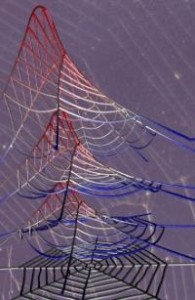A March 29, 2022 news item on ScienceDaily highlights research into how spiders hear,
Everyone knows that humans and most other vertebrate species hear using eardrums that turn soundwave pressure into signals for our brains. But what about smaller animals like insects and arthropods? Can they detect sounds? And if so, how?
Distinguished Professor Ron Miles, a Department of Mechanical Engineering faculty member at Binghamton University’s Thomas J. Watson College of Engineering and Applied Science, has been exploring that question for more than three decades, in a quest to revolutionize microphone technology.
A newly published study of orb-weaving spiders — the species featured in the classic children’s book “Charlotte’s Web” — has yielded some extraordinary results: The spiders are using their webs as extended auditory arrays to capture sounds, possibly giving spiders advanced warning of incoming prey or predators.
…
Binghamton University (formal name: State University of New York at Binghamton) has made this fascinating (to me anyway) video available,
Binghamton University and Cornell University (also in New York state) researchers worked collaboratively on this project. Consequently, there are two news releases and there is some redundancy but I always find that information repeated in different ways is helpful for learning.
A March 29, 2022 Binghamton University news release (also on EurekAlert) by Chris Kocher gives more detail about the work (Note: Links have been removed),
It is well-known that spiders respond when something vibrates their webs, such as potential prey. In these new experiments, researchers for the first time show that spiders turned, crouched or flattened out in response to sounds in the air.
The study is the latest collaboration between Miles and Ron Hoy, a biology professor from Cornell, and it has implications for designing extremely sensitive bio-inspired microphones for use in hearing aids and cell phone
Jian Zhou, who earned his PhD in Miles’ lab and is doing postdoctoral research at the Argonne National Laboratory, and Junpeng Lai, a current PhD student in Miles’ lab, are co-first authors. Miles, Hoy and Associate Professor Carol I. Miles from the Harpur College of Arts and Sciences’ Department of Biological Sciences at Binghamton are also authors for this study. Grants from the National Institutes of Health to Ron Miles funded the research.
A single strand of spider silk is so thin and sensitive that it can detect the movement of vibrating air particles that make up a soundwave, which is different from how eardrums work. Ron Miles’ previous research has led to the invention of novel microphone designs that are based on hearing in insects.
“The spider is really a natural demonstration that this is a viable way to sense sound using viscous forces in the air on thin fibers,” he said. “If it works in nature, maybe we should have a closer look at it.”
Spiders can detect miniscule movements and vibrations through sensory organs on their tarsal claws at the tips of their legs, which they use to grasp their webs. Orb-weaver spiders are known to make large webs, creating a kind of acoustic antennae with a sound-sensitive surface area that is up to 10,000 times greater than the spider itself.
In the study, the researchers used Binghamton University’s anechoic chamber, a completely soundproof room under the Innovative Technologies Complex. Collecting orb-weavers from windows around campus, they had the spiders spin a web inside a rectangular frame so they could position it where they wanted.
The team began by using pure tone sound 3 meters away at different sound levels to see if the spiders responded or not. Surprisingly, they found spiders can respond to sound levels as low as 68 decibels. For louder sound, they found even more types of behaviors.
They then placed the sound source at a 45-degree angle, to see if the spiders behaved differently. They found that not only are the spiders localizing the sound source, but they can tell the sound incoming direction with 100% accuracy.
To better understand the spider-hearing mechanism, the researchers used laser vibrometry and measured over one thousand locations on a natural spider web, with the spider sitting in the center under the sound field. The result showed that the web moves with sound almost at maximum physical efficiency across an ultra-wide frequency range.
“Of course, the real question is, if the web is moving like that, does the spider hear using it?” Miles said. “That’s a hard question to answer.”
Lai added: “There could even be a hidden ear within the spider body that we don’t know about.”
So the team placed a mini-speaker 5 centimeters away from the center of the web where the spider sits, and 2 millimeters away from the web plane — close but not touching the web. This allows the sound to travel to the spider both through air and through the web. The researchers found that the soundwave from the mini-speaker died out significantly as it traveled through the air, but it propagated readily through the web with little attenuation. The sound level was still at around 68 decibels when it reached the spider. The behavior data showed that four out of 12 spiders responded to this web-borne signal.
Those reactions proved that the spiders could hear through the webs, and Lai was thrilled when that happened: “I’ve been working on this research for five years. That’s a long time, and it’s great to see all these efforts will become something that everybody can read.”
The researchers also found that, by crouching and stretching, spiders may be changing the tension of the silk strands, thereby tuning them to pick up different frequencies. By using this external structure to hear, the spider could be able to customize it to hear different sorts of sounds.
Future experiments may investigate how spiders make use of the sound they can detect using their web. Additionally, the team would like to test whether other types of web-weaving spiders also use their silk to outsource their hearing.
“It’s reasonable to guess that a similar spider on a similar web would respond in a similar way,” Ron Miles said. “But we can’t draw any conclusions about that, since we tested a certain kind of spider that happens to be pretty common.”
Lai admitted he had no idea he would be working with spiders when he came to Binghamton as a mechanical engineering PhD student.
“I’ve been afraid of spiders all my life, because of their alien looks and hairy legs!” he said with a laugh. “But the more I worked with spiders, the more amazing I found them. I’m really starting to appreciate them.”
A March 29, 2022 Cornell University news release (also on EurekAlert but published March 30, 2022) by Krishna Ramanujan offers a somewhat different perspective on the work, Note: Links have been removed)
Charlotte’s web is made for more than just trapping prey.
A study of orb weaver spiders finds their massive webs also act as auditory arrays that capture sounds, possibly giving spiders advanced warning of incoming prey or predators.
In experiments, the researchers found the spiders turned, crouched or flattened out in response to sounds, behaviors that spiders have been known to exhibit when something vibrates their webs.
The paper, “Outsourced Hearing in an Orb-weaving Spider That Uses its Web as an Auditory Sensor,” published March 29 [2022] in the Proceedings of the National Academy of Sciences, provides the first behavioral evidence that a spider can outsource hearing to its web.
The findings have implications for designing bio-inspired extremely sensitive microphones for use in hearing aids and cell phones.
A single strand of spider silk is so thin and sensitive it can detect the movement of vibrating air particles that make up a sound wave. This is different from how ear drums work, by sensing pressure from sound waves; spider silk detects sound from nanoscale air particles that become excited from sound waves.
“The individual [silk] strands are so thin that they’re essentially wafting with the air itself, jostled around by the local air molecules,” said Ron Hoy, the Merksamer Professor of Biological Science, Emeritus, in the College of Arts and Sciences and one of the paper’s senior authors, along with Ronald Miles, professor of mechanical engineering at Binghamton University.
Spiders can detect miniscule movements and vibrations via sensory organs in their tarsi – claws at the tips of their legs they use to grasp their webs, Hoy said. Orb weaver spiders are known to make large webs, creating a kind of acoustic antennae with a sound-sensitive surface area that is up to 10,000 times greater than the spider itself.
In the study, the researchers used a special quiet room without vibrations or air flows at Binghamton University. They had an orb-weaver build a web inside a rectangular frame, so they could position it where they wanted. The team began by putting a mini-speaker within millimeters of the web without actually touching it, where sound operates as a mechanical vibration. They found the spider detected the mechanical vibration and moved in response.
They then placed a large speaker 3 meters away on the other side of the room from the frame with the web and spider, beyond the range where mechanical vibration could affect the web. A laser vibrometer was able to show the vibrations of the web from excited air particles.
The team then placed the speaker in different locations, to the right, left and center with respect to the frame. They found that the spider not only detected the sound, it turned in the direction of the speaker when it was moved. Also, it behaved differently based on the volume, by crouching or flattening out.
Future experiments may investigate whether spiders rebuild their webs, sometimes daily, in part to alter their acoustic capabilities, by varying a web’s geometry or where it is anchored. Also, by crouching and stretching, spiders may be changing the tension of the silk strands, thereby tuning them to pick up different frequencies, Hoy said.
Additionally, the team would like to test if other types of web-weaving spiders also use their silk to outsource their hearing. “The potential is there,” Hoy said.
Miles’ lab is using tiny fiber strands bio-inspired by spider silk to design highly sensitive microphones that – unlike conventional pressure-based microphones – pick up all frequencies and cancel out background noise, a boon for hearing aids.
…
Here’s a link to and a citation for the paper,
Outsourced hearing in an orb-weaving spider that uses its web as an auditory sensor by Jian Zhou, Junpeng Lai, Gil Menda, Jay A. Stafstrom, Carol I. Miles, Ronald R. Hoy, and Ronald N. Miles. Proceedings of the National Academy of Sciences (PNAS) DOI: https://doi.org/10.1073/pnas.2122789119 Published March 29, 2022 | 119 (14) e2122789119
This paper appears to be open access and video/audio files are included (you can heat the sound and watch the spider respond).

